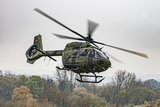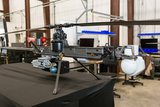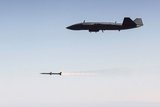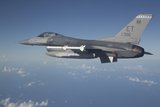Boeing delivers first F/A-18 Block III Super Hornets to USN
Boeing on 17 June confirmed that it has delivered the first two F/A-18E/F Block III Super Hornets to the USN for flight testing.
The aircraft will be used to train pilots in using the platform’s new 10-inch by 19-inch touchscreen display and to test the network capabilities.
Steve Wade, Boeing VP of F/A-18 & E/A-18G programmes, said: ‘The aircraft will be used for carrier suitability and integration testing of all Block III mission system components… These test jets will ensure crews have plenty of time to become comfortable with the new, next-generation systems before receiving operational aircraft.’
Boeing has also extended the life cycle of the Block III from 6,000 operational hours to 10,000 hours whilst also upgrading its communication system and reducing its radar signature.
As part of our promise to deliver comprehensive coverage to our Defence Insight and Premium News subscribers, our curated defence news content provides the latest industry updates, contract awards and programme milestones.
Related Equipment in Defence Insight
More from Air Warfare
-
![Germany acquires additional 20 H145M helicopters]()
Germany acquires additional 20 H145M helicopters
The order for the extra helicopters comes from an agreement penned in December 2023, with the German Army receiving the bulk of the platforms.
-
![Anduril UK and GKN Aerospace collaborate on British Army ACP bid]()
Anduril UK and GKN Aerospace collaborate on British Army ACP bid
The pair will submit their demonstrator concept for Project Nyx, a development project for the British Army’s Land Autonomous Collaborative Platform.
-
![US Army command’s Picatinny CLIK common lethal drone interface makes progress]()
US Army command’s Picatinny CLIK common lethal drone interface makes progress
The Picatinny Common Lethality Integration Kit is designed to overcome the issue of unique integration methods between lethal payloads and drones as well as avoiding problematic acquisition conditions created by vendor lock.
-
![Australia invests extra A$1.4 billion in MQ-28A Ghost Bat after successful missile fire test]()
Australia invests extra A$1.4 billion in MQ-28A Ghost Bat after successful missile fire test
The investment includes new contracts for six MQ-28A Ghost Bat aircraft, as well as provisional funds to invest in the development of a Block 3 prototype.
-
![US approves potential $4.7 billion missile and air defence system sales to Denmark and Italy]()
US approves potential $4.7 billion missile and air defence system sales to Denmark and Italy
Italy could field the JASSM-ER for its combat aircraft including the F-35, while Denmark has been approved for AMRAAM and an Integrated Battle Command system procurement.
-
![Northrop Grumman to fly new Project Talon CCA by late 2026]()
Northrop Grumman to fly new Project Talon CCA by late 2026
The newly unveiled collaborative combat aircraft looks to strike a balance between capability and cost-effectiveness, according to the company.

























